利用弧形轮床襟翼提高水平轴风力涡轮机的性能:三维数值研究
IF 1.1
4区 工程技术
Q3 ENGINEERING, MECHANICAL
Proceedings of the Institution of Mechanical Engineers, Part A: Journal of Power and Energy
Pub Date : 2023-11-24
DOI:10.1177/09576509231214929
引用次数: 0
摘要
本研究分析了 Gurney 弧形襟翼对 660 千瓦 V47 水平轴风力涡轮机(HAWT)性能的影响。涡轮叶片的后缘通过弧形襟翼进行被动修正。使用雷诺平均纳维-斯托克斯求解器和剪应力-传输湍流模型求解连续性和动量方程。研究探讨了弧形襟翼的方向和半径对风力涡轮机空气动力性能(扭矩和发电、流体分离和推力负荷)的影响。研究探讨了叶片俯仰角([计算公式:见正文])和风速([计算公式:见正文])如何影响弧形襟翼在 HAWT 上的性能。结果表明,弧形襟翼在较低的桨距角([计算公式:见正文])下对输出扭矩有积极影响。曲线襟翼[公式:见正文]和[公式:见正文]的平均扭矩增幅为 3.7%,而平面襟翼仅为 2.9%。这一结论不适用于较高的俯仰角([公式:见正文]),因为襟翼会破坏气动性能。此外,与其他弧形襟翼甚至平襟翼相比,使用半径为[公式:见正文]的弧形襟翼(内向型)可以提高产生的扭矩(最高可达[公式:见正文]),尤其是在额定工作点附近。这一结论适用于[计算公式:见正文],而对于较高的俯仰角,平坦的古尼襟翼一般具有更好的性能。本文章由计算机程序翻译,如有差异,请以英文原文为准。
Performance improvement of horizontal axis wind turbines using curved gurney flap: 3D numerical investigation
The impact of curved Gurney flaps on the performance of a 660 kW V47 horizontal axis wind turbine (HAWT) is analyzed in this study. The trailing edge of the turbine blades is passively modified by curved flaps. The continuity and momentum equations are solved using a Reynolds-averaged Navier-Stokes solver and Shear-Stress-Transport turbulent model. The effect of the direction and radius of curved flaps on the aerodynamic performance of the wind turbine (torque and power generation, flow separation, and thrust loads) is examined. The study examines how the curved flap’s performance on HAWT is affected by the blade pitch angle ([Formula: see text]) and wind speed ([Formula: see text]). According to the results, curve flaps have a positive impact on the output torque at lower pitch angles ([Formula: see text]). The average torque increase for [Formula: see text] and [Formula: see text] is 3.7% for curve flaps, while it is only 2.9% for flat flaps. This conclusion is not valid for higher pitch angles ([Formula: see text]) where the flap disrupts the aerodynamic performance. Further, the use of curve flaps with the radius of [Formula: see text] (inward-type) can improve the torque produced (up to [Formula: see text]) compared to other curved flaps and even flat flaps, especially around the nominal operating point. This conclusion is valid for [Formula: see text], while for higher pitch angles, the flat Gurney flap has better performance generally.
求助全文
通过发布文献求助,成功后即可免费获取论文全文。
去求助
来源期刊

CiteScore
3.30
自引率
5.90%
发文量
114
审稿时长
5.4 months
期刊介绍:
The Journal of Power and Energy, Part A of the Proceedings of the Institution of Mechanical Engineers, is dedicated to publishing peer-reviewed papers of high scientific quality on all aspects of the technology of energy conversion systems.
 求助内容:
求助内容: 应助结果提醒方式:
应助结果提醒方式:


